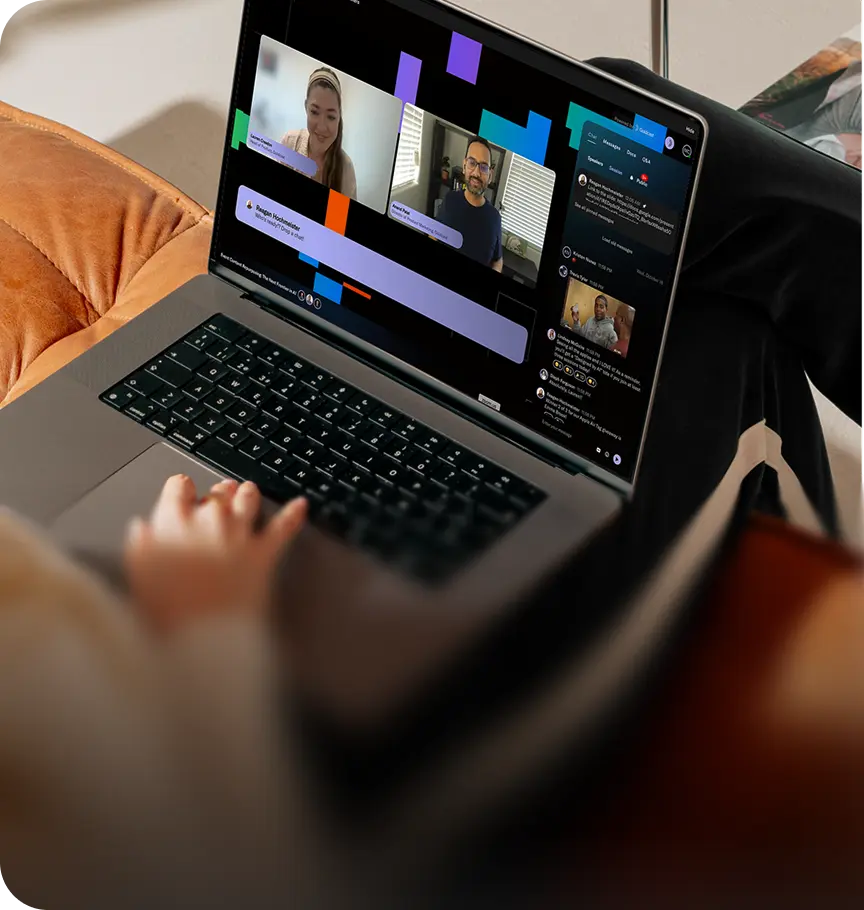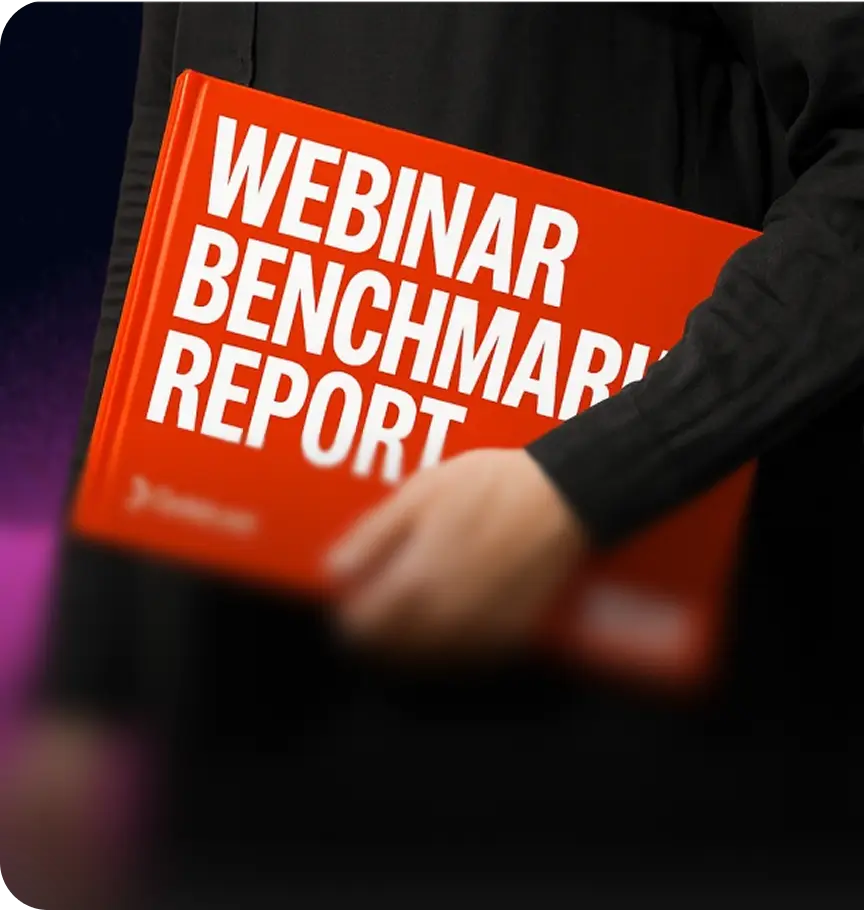How to Rank YouTube Videos in Google Search (Without Spending a Dime)

Table of Contents
Maximize Your Marketing ROI
Join 10,000 other marketers already getting the best tips on running engaging events that boost pipeline and create raving fans.
There’s nothing more perplexing than watching some scrappy video clip sneak its way to the top of Google search results — especially if you've been throwing a ton of budget behind beating the algorithm.
But what if I told you that you too can rank on Google without spending even a cent?
(Note that I didn't say it was easy. I'm just here to say it's possible.)
The problem is that most people are going about the whole thing backwards. In B2B, we love our frameworks and funnels, but for some reason, we get to video and just toss content into the void, praying that folks will find it.
That’s not strategy. That’s wishful indexing.
The truth is, Google WANTS to rank your videos. It’s actively looking for reasons to. You just have to give it what it wants.
This guide is all about outsmarting, not outspending. It’s about how we think about videos at Goldcast, and how we get our content to show up before intent signals even appear. Because attention — and Mindshare — are built early, and you need to get started now.
Building Mindshare is a long game
In a perfect world, your audience would just … know. They'd already be completely aware of you and why your company is the best at what you do.
They'd type your company name into Google (spelled perfectly, of course), navigate to your website, and then watch every video you've ever created — twice, before sharing with their networks.
Sadly, this isn't a perfect world. Attention is earned. Sloooowly. Painstakingly. But video is one of the few mediums that can collapse time-to-trust while scaling your story.
Yet B2B marketers are still out here treating YouTube like an overcrowded parking lot where they send their webinars and demos to die. Then they wonder why nothing's ranking and why no one's watching their content.
By changing your approach and getting your YouTube videos to show up in Google search, you're meeting your buyers where they are, long before they even know they need you. We call it Mindshare because you're claiming that mental real estate while it's still available and ensuring you're right there on the tip of everyone's tongue when it's time to make a purchasing decision.
But you've gotta be intentional to get there!
Google vs. YouTube: different algorithms, different games
Before we get more into the weeds, I need to talk about the ways videos get fed to viewers.
YouTube’s algorithm is basically Tinder for content (albeit with a little less of an NSFW edge). YouTube is trying to match viewers with videos they’ll stick around for and swipe right on. It’s fueled by watch time, engagement, and user behavior inside the platform.
Google’s algorithm, on the other hand, acts more like a librarian — practical and helpful, above all else. It’s scanning everything on the internet, asking: “Does this video answer the searcher’s question?" and "Can I trust this video to not make me look stupid for recommending it?”
So, you might get the same video on each platform, but through very different ways.
When I launched a video podcast series, we optimized everything for YouTube discovery: thumbnails, titles, descriptions, etc. The result? Decent traction, decent views.
But the moment we optimized just ONE episode around a high-intent Google search term and embedded that into a blog post — it tripled watch time and started pulling consistent traffic from Google.
Different channels, different signals.
Remember: YouTube wants you to hook you and keep you watching. Google wants you to get the answer you're looking for. Nail both with your video content, and you’re cooking.
How to rank YouTube videos in Google (without paying, praying, or guessing)
You came for the playbook, so let's go. Here’s the approach I use personally and how we work at Goldcast, step-by-step. I like to call this strategy: ranking like you've got budget (even if you don't).
1. Use Google's Video tab for keyword research
Instead of choosing random topics and hoping they rank, use Google's own behavior to guide your content roadmap. Start with business-critical keywords (think “employee onboarding software” or “B2B video platform”) and Google them.
Then click on the Video tab. This is totally underused! It'll show you exactly which YouTube videos are ranking organically in Google search.
If a video shows up here, you can trust that it's doing two things really well:
- Satisfying search intent
- Earning enough trust for Google to serve them up
When I’m doing this for Goldcast, I use a tool like Ahrefs or Semrush to pull a list of high-intent, mid-funnel keywords. Then I manually scan those terms in Google’s Video tab and look for gaps:
- No videos ranking = white space
- Old or off-topic videos ranking = quality gap
- Videos from brands that aren’t competitors = brand opportunity
And here's where it gets fun: I cross-check the same keywords on YouTube. If a keyword has decent volume there but weak competition in Google’s video tab? That’s a signal. That’s your green light.
Now instead of guessing what video to make next, you’re reverse-engineering proven demand. You’re creating videos that the algorithm is already hungry for, filling in the Google gaps.
2. Front-load titles to immediately grab attention
Here’s the truth: Google doesn’t care how cinematic your intro is. It cares if your title tells the searcher, within seconds, “HEY! This is what you’re looking for.”
Think:
✅ AI Video Strategy: Your 2025 Playbook❌ Your Ultimate Guide to AI Video Strategy for 2025
That first one wins because it’s short, direct, and clear about the value. The keyword shows up early, so Google gets it. And so does the person searching.
But this goes deeper than just stacking keywords like you’re playing SEO Jenga. It’s about intent clarity. The keywords you choose send signals — to Google and to buyers — about where you fit in their decision-making process.
Here’s how I think about keywords when building titles at Goldcast:
1. Category-defining keywords
These are everything. If you’re in the “virtual event platform” or “B2B content tool” space, your video needs to say that. Loudly. Clearly. Early.
If your title doesn’t make it obvious what space you’re in, don’t be shocked when no one in that space sees it.
2. Problem-aware keywords
People don’t search, "How do I adopt a multi-channel growth stack?” They search for things like, “How do I get more qualified leads without spending $30k/month on ads?”
Try to think about how real people look for information around their pain points. Then, point them toward your solution.
3. Intent-rich modifiers
When your audience is past the casual research stage, they start looking for more strategic info. They want specific information to make a final decision — or justify the one they've already made.
Add words like "framework," "plan," "playbook," "for 2025," and "best practices" to your titles to capture these folks.
4. Bottom-of-funnel comparison terms
BoFu is where things get more direct:
- “Best event marketing tool for SaaS”
- “Goldcast vs. Sequel”
- “RingCentral alternatives”
These searchers aren’t browsing. They’re picking finalists. And if you can rank here, you’re in the room when decisions are made.
3. Video descriptions are extra SEO opps
If your video description reads like an afterthought, Google will treat it like one. I learned this the hard way. I used to think of descriptions as the YouTube version of fine print: Slap in a sentence or two that no one will ever read, toss in a link, and move on.
Spoiler: that doesn’t rank.
Now, I treat every description like it’s my second shot at SEO.
Here’s the play: Aim for 250–300 words, and write like a human who knows what a robot is looking for. Weave in keywords naturally, break things up with clear sections (timestamps are a cheat code for this), and always make the first two lines the most impactful — they show up right under your video in search.
Pro tip: I love to sneak in a short Q&A at the end of descriptions. Why? Because Google loves answering questions in featured snippets. Give it something to work with, and suddenly your video isn’t just a piece of content — it’s a search result star.
4. Strong thumbnails → amazing CTR
Crappy thumbnails are a personal pet peeve. You can do everything right — killer title, perfect description, strong keywords — and still tank if your thumbnail looks like a blurry screenshot. No one wants to click on a photo that looks like it was designed in PowerPoint 2003!
And you need people to click because Google pays attention to CTR (click-through rate). If a lot of people click on your video, Google rewards you.
That means your thumbnail has one job and one job only: Be irresistible. Use bold colors and strong fonts (3-4 words max, usually). Make sure the visuals are clean. Most importantly: Check to see if the value is communicated at a glance.
The thumbnail from our "Stop Sliming" campaign is a perfect example. There's a clear, intriguing visual and compelling copy. Who doesn't want to start shining? I'm clicking for sure.
5. Prompt people to engage with the content
I make it a rule in our videos to directly prompt viewers. Not in an annoying “Smash that like button and subscribe!” kind of way, but in a way that builds the conversation between Goldcast and our audience.
For example:
- “Did this shift your thinking? Drop a comment and let’s keep the conversation going.”
- “What’s your biggest challenge with video SEO? Let us know below. We’re listening!”
When people respond to these prompts, Google understands that your content matters to people. Comments, likes, shares — they're the collective breadcrumbs that lead back to Google deciding that your video is worth showing.
6. Strategic playlists dominate multiple search spots
A keyword-rich playlist can rank independently in Google search, even if the individual videos don't. That means more search surface area and more ways to sneak your brand into the convo without creating new content.
We’re still early testing this at Goldcast, but I’ve already seen how powerful it can be. Especially for mid-funnel terms like “customer retention strategies” or “SaaS onboarding frameworks,” I’ve watched playlists climb up Google’s rankings even when the videos themselves barely cracked page two.
Playlists have been a big ah-ha moment for me. If one video is like a blog post, a playlist is like a well-structured blog series. And we all know Google loves a good structure.
The best part? This is a tactic most people ignore because creating the playlists feels like admin work. But while everyone else is busy obsessing over their next new upload, you can quietly stack your playlists, build out keyword clusters, and extend your reach without needing to reinvent the wheel.
7. Embed to win and raise video visibility
As a content marketer, you probably know that distribution isn’t optional — it’s the whole job. And nowhere is that clearer than when it comes to embedding your videos.
We’ve started leaning into this more at Goldcast, especially now that we’re sharing full videos (made in Content Lab) from our YouTube.
Here’s what I’m seeing so far: When your video lives inside a blog post, a newsletter, or a LinkedIn article, it stops being just a video. It becomes part of a broader story. And that’s where the magic happens.
Embedding is contextual distribution. It tells Google:
- This video isn’t random.
- It’s relevant.
- People are talking about it in places that matter.
Here’s how I think about it:If you just drop a YouTube link on social, sure, you might get a few clicks. But when you embed that same video inside a thoughtful blog post, or you create a LinkedIn post that provides more context, your video becomes much more than its original form. It’s now part of the narrative. It reinforces your expertise.
Every embed is a backlink. Every backlink is a trust signal. Give Google more reasons to trust your content.
8. Intelligent tagging: Google’s algorithm loves context
Let’s talk about something wildly unsexy but stupidly important: tags.
Tags can feel like just filler — something you slap on at the end of uploading a video so you can finally hit publish. But here’s what I’ve learned: Tags are like the town journalists.
If tags don’t tell Google what your video is about (and who should care about it), you’re invisible.
So, how do I decide what to tag at Goldcast? Once again, by observing and reverse-engineering.
Here’s my tag strategy:
Step 1: Anchor to intent, not just keywordsThis is where most people trip up. Some tag “B2B SaaS” and call it a day. Don't do that. No one types in "B2B SaaS" when they're looking for help!
Instead, tag like your ideal customer is literally typing a question. For example: “how to run a virtual event that converts” is a great tag because that's how people actually look things up.
Step 2. Mine related videosFind the top-performing videos in your space. Use TubeBuddy, VidIQ, or old-school source-viewing to extract their tags. It’s your algorithmic cheat sheet because it’s what Google’s already rewarding.
Step 3. Balance the stackThink of tags like an investment portfolio:
- 1–2 primary keywords (“event marketing strategy”)
- 3–5 mid-funnel modifiers (“virtual event engagement tips”)
- 2–3 brand/POV tags (“Goldcast,” “mindshare marketing”)
- 1–2 synonyms or adjacent interest tags (“webinar analytics”)
Step 4. Repeat what you want to rank forThis is a long game. Be consistent. Tag your videos the same way every time when they cover related topics. That repetition trains the algorithm to trust you on those subjects.
Step 5. Tag for people (not just platforms)The algorithm is trying to predict human behavior, so you need to use the words your audience actually says in meetings, in Slack, and in Google searches. Don't focus on the terms your team uses internally; tag for the people you're trying to reach.
9. Get the most watch time
If there’s one thing I’ve learned after publishing (and over-analyzing) way too many videos, it’s that Google doesn’t care what you say. It cares how long people stick around to hear it.
Watch time is everything. High retention makes Google think that your content must be good if that many people are staying to see it. Then, it'll start showing your video more often, in more places.
At Goldcast, we’re always asking: How do we get people to watch just a little longer?
The formula’s actually pretty simple:
- Hook early: Don’t waste 30 seconds explaining why the topic matters. Your viewer already knows; that’s why they clicked. Give them a valuable reason to stay within the first 5 seconds.
- Deliver immediately: Show, don’t tell. This is where a lot of B2B content bloats out. Resist the urge to over-contextualize and jump straight to the good stuff. You don’t need to prove you’re an expert — you need to actually be one.
- Cut the fluff: Every extra second of filler is an invitation to bounce. Respect your viewer’s time, and they’ll repay you with higher retention and more trust in your brand.
The big takeaway: Make your content bingeable, not just clickable.
10. Leverage communities for natural visibility
Not every B2B buyer is in a YouTube rabbit hole scavenging for product videos. But you know where they are hanging out? Slack groups. Reddit threads. Medium posts. LinkedIn comments.
The watering holes are where real conversations happen, so make sure you're there, too.
We’ve been doing this a lot lately, sharing content not just through official channels, but via employees, partners, and even (shocker) real community members who actually care about the same things we do.
When your video gets naturally distributed in these spaces, two things happen:
- Watch time goes up: because the right people are watching with real intent.
- Engagement quality improves: because your video is showing up in context, not just floating around aimlessly.
I’ve seen videos get a massive lift just from being shared by a few key team members on LinkedIn or featured in a community newsletter. This tactic is low-cost, high-impact, and honestly, a welcome reminder that the human side of distribution still matters just as much as the algorithmic one.
Ranking in Google isn't magic — it's method
We've covered all the essentials here: from using Google's Video tab to find keyword ideas to hooking (and keeping) people's interest with your videos.
I hope you walk away knowing this for sure: visibility and trust go hand in hand.
Google gets you in the door. Your content keeps people around.
And you don’t need a massive budget to do any of this — just a smart, repeatable process that treats Google like the practical helper it is while giving YouTube the engagement it craves.
At Goldcast, we’re still refining our approach every day. But the throughline is clear: Meet your audience where they search, deliver value fast, and never underestimate the compounding power of tiny optimizations.
It’s not about outsmarting the algorithm; it’s about getting to know it so you can work with it. That's something most people overlook and where the real opportunities lie.
Transform Your Video Marketing with AI
Stay In Touch
Platform
Resources
© 2025 Copyright Goldcast, Inc. All rights reserved.





 Upcoming Events
Upcoming Events Event Series
Event Series On-Demand Events
On-Demand Events

